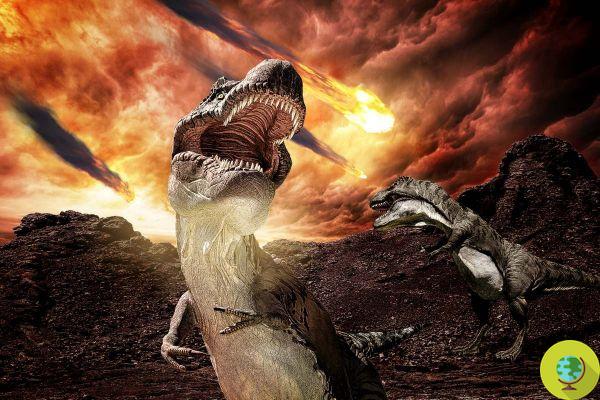
Dinosaurs weren't in decline before the asteroid wiped them out. This was announced by a new study by the NHM
He is about to end up run over, his mother saves himDinosaurs weren't in decline before the asteroid wiped them out. This was announced by a new study according to which it was an asteroid that paved the way for their extinction.
The violent impact and the consequences caused by the space rock, which landed on Earth 66 million years ago, ended up exterminating the large animals that were prospering peacefully on the planet at the time.
This goes against previous assumptions that non-avian dinosaurs were already in decline and headed for extinction when the asteroid hit Earth in the late Cretaceous, ending the dinosaur reign and allowing mammals to diversify.
Recently various hypotheses had considered that the extinction of the dinosaurs, before the arrival of the asteroid, was now inevitable: the diversity of these ancient animals was decreasing even before and they they would have died out anyway.
But the new study, led by scientists at the British Museum of Natural History and published in the journal Royal Society Open Science, came to a different conclusion, showing instead that many groups of dinosaurs were actually doing very well at the time of the potential impact. This was discovered by Joe Bonsor, a doctoral student at the Museum, who added more up-to-date and different data to conduct the computational analysis that led him to a different point of view.
The asteroid that extinguished the dinosaurs 66 million years ago had the deadliest "angle of impact" that could be had
According to Bonsor, large hadrosaur dinosaurs, such as Edmontosaurus, were doing incredibly well when the asteroid hit Earth.
“What we found is that dinosaurs were still dominant and widespread and still doing very well,” explains Joe. "If the impact with the asteroid had never occurred, perhaps they would not have become extinct living even after the Cretaceous."
This has cast doubt on the pessimistic claims that dinosaurs were already dying out, as much of the information about these events is based on fragmentary and therefore distorted fossil records.
Diversity of dinosaurs
The history of the dinosaurs spans an incredible amount of time. First appearing during the Triassic around 230 million years ago, they have evolved into an enormous diversity of shapes and sizes. From tiny animals barely 50 centimeters long to enormous creatures of 35 meters, some with elaborate crests on their heads, others with enormous teeth and large, powerful jaws. Some were covered entirely in scales, while others developed tufts of feathers or even a complete downy cover.
It is this extraordinary range that, in part, would have helped them dominate the earth for over 150 million years.
Previous studies have suggested that dinosaur dominance was about to end naturally and that this incredible diversity was starting to diminish. It was mostly fossil-based research to model dinosaur family trees over time.
But only a small fraction of what was alive at any given time is transformed into a fossil. By looking at more groups of dinosaurs to create more up-to-date and detailed family trees, the new research sheds light on one aspect:
“The main point of what we're saying is that we don't have enough data to know what would have happened to the dinosaurs either way. There is generally a bias in the fossil record towards lack of data, and interpreting these gaps in the fossil record as an artificial decline in diversification rates is not what we should be doing. Instead, we have shown that there is no clear evidence that they were dying, and that the only way to know for sure is to fill in the gaps in the fossil record, ”said the study's author.
Until the late Cretaceous, huge animals such as hadrosaurs, ceratopsians, and ankylosaurs were the dominant herbivores in North America, while giant titanosaurs could still be found globally. These animals would have shaped the environment in an extremely significant way. Some of the largest carnivores that ever existed still thrived until the late Cretaceous. Other large predators were also still alive.
We do not know what would have happened if the dinosaurs had not become extinct, perhaps evolution would not have led to the birth of the human species either.
Sources of reference: Nhm, Royal Society Open Science
READ also:
- Sixth mass extinction discovered, which shaped the world as we know it (and paved the way for dinosaurs)
- A starburst may have resulted in a mass extinction on Earth


























